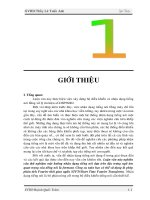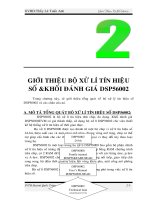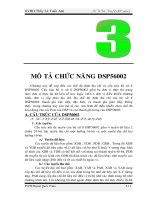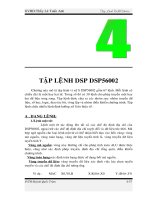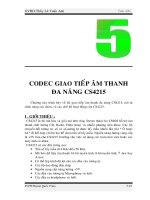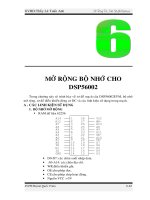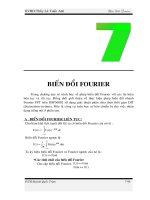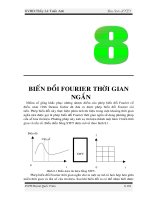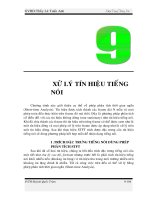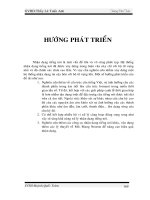xây dựng bộ điều khiển và nhận dạng tiếng nói bằng xử lý
Bạn đang xem bản rút gọn của tài liệu. Xem và tải ngay bản đầy đủ của tài liệu tại đây (716.05 KB, 110 trang )
MOTOROLA
SEMICONDUCTOR TECHNICAL DATA
DSP56002
Order
this
doc
u
ment
b
y:
DSP56002/D, Rev. 3
©1996 MOTOROLA, INC.
24-BIT DIGITAL SIGNAL PROCESSOR
The DSP56002 is a MPU-style general purpose Digital Signal Processor (DSP) composed of an
efficient 24-bit DSP core, program and data memories, various peripherals, and support
circuitry. The DSP56000 core is fed by on-chip Program RAM, and two independent data RAMs.
The DSP56002 contains a Serial Communication Interface (SCI), Synchronous Serial Interface (SSI),
parallel Host Interface (HI), Timer/Event Counter, Phase Lock Loop (PLL), and an On-Chip
Emulation (OnCE™) port. This combination of features, illustrated in
Figure 1
, makes the
DSP56002 a cost-effective, high-performance solution for high-precision general purpose digital
signal processing.
Figure 1
DSP56002 Block Diagram
Y Data
Memory
256 × 24 RAM
256 × 24 ROM
(sine)
X Data
Memory
256 × 24 RAM
256 × 24 ROM
(A-law/ µ-law)
Program
Memory
512 × 24 RAM
64 × 24 ROM
(boot)
Program Control Unit
24-bit
56000 DSP
Core
OnCE™
PLL
Clock
Gen.
1
24-bit
Timer/
Event
Counter
6
Sync.
Serial
(SSI)
or I/O
3
Serial
Comm.
(SCI)
or I/O
15
Host
Interface
(HI)
or I/O
16-bit Bus
24-bit Bus
External
Address
Bus
Switch
External
Data
Bus
Switch
Bus
Control
Data ALU
24 × 24 + 56 → 56-bit MAC
Two 56-bit Accumulators
3
IRQ
47
Internal
Data
Bus
Switch
Address
Generation
Unit
PAB
XAB
YAB
GDB
PDB
XDB
YDB
Address
16
Data
24
Control
10
Port
AA0604
Program
Address
Generator
Program
Decode
Controller
Interrupt
Control
ii DSP56002/D, Rev. 3 MOTOROLA
SECTION 1 PIN DESCRIPTIONS . . . . . . . . . . . . . . . . . . . . . . . . . . . . . . . . . . . . .1-1
SECTION 2 SPECIFICATIONS . . . . . . . . . . . . . . . . . . . . . . . . . . . . . . . . . . . . . . .2-1
SECTION 3 PACKAGING . . . . . . . . . . . . . . . . . . . . . . . . . . . . . . . . . . . . . . . . . . .3-1
SECTION 4 DESIGN CONSIDERATIONS . . . . . . . . . . . . . . . . . . . . . . . . . . . . . .4-1
SECTION 5 ORDERING INFORMATION . . . . . . . . . . . . . . . . . . . . . . . . . . . . . . .5-1
FOR TECHNICAL ASSISTANCE:
Telephone: 1 (800) 521-6274
Email:
Internet:
Data Sheet Conventions
T
his data sheet uses the following conventions:
OVERBAR Used to indicate a signal that is active when pulled low (For example, the RESET
pin is active when low.)
“asserted” Means that a high true (active high) signal is high or that a low true (active low)
signal is low
“deasserted” Means that a high true (active high) signal is low or that a low true (active low)
signal is high
Examples:
Signal/Symbol Logic State Signal State
Voltage
1
PIN True Asserted V
IL
/V
OL
PIN False Deasserted V
IH
/V
OH
PIN True Asserted V
IH
/V
OH
PIN False Deasserted V
IL
/V
OL
Note: Values for V
IL
, V
OL
, V
IH
, and V
OH
are defined by individual product specifications.
DSP56002
Features
MOTOROLA DSP56002/D, Rev. 3 iii
FEATURES
Digital Signal Processing Core
• Efficient 24-bit DSP56000 core
• Up to 40 Million Instructions Per Second (MIPS), 25 ns instruction cycle at
80 MHz; up to 33 MIPS, 30.3 ns instruction cycle at 66 MHz
• Up to 240 Million Operations Per Second (MOPS) at 80 MHz; up to 198 MOPS
at 66 MHz
• Performs a 1024-point complex Fast Fourier Transform (FFT) in 59,898 clocks
• Highly parallel instruction set with unique DSP addressing modes
• Two 56-bit accumulators including extension bits
• Parallel 24
×
24-bit multiply-accumulate in 1 instruction cycle (2 clock cycles)
• Double precision 48
×
48-bit multiply with 96-bit result in 6 instruction cycles
• 56-bit addition/subtraction in 1 instruction cycle
• Fractional and integer arithmetic with support for multiprecision arithmetic
• Hardware support for block-floating point FFT
• Hardware nested DO loops
• Zero-overhead fast interrupts (2 instruction cycles)
• Four 24-bit internal data buses and three 16-bit internal address buses for
maximum information transfer on-chip
Memory
• On-chip Harvard architecture permitting simultaneous accesses to program
and two data memories
• 512
×
24-bit on-chip Program RAM and 64
×
24-bit bootstrap ROM
• Two 256
×
24-bit on-chip data RAMs
• Two 256
×
24-bit on-chip data ROMs containing sine, A-law, and
µ
-law tables
• External memory expansion with 16-bit address and 24-bit data buses
• Bootstrap loading from external data bus, Host Interface, or Serial
Communications Interface
iv DSP56002/D, Rev. 3 MOTOROLA
Features
Peripheral and Support Circuits
• Byte-wide host interface (HI) with Direct Memory Access (DMA) support (or
fifteen Port B GPIO lines)
• SSI support:
– Supports serial devices with one or more industry-standard codecs, other
DSPs, microprocessors, and Motorola-SPI-compliant peripherals
– Asynchronous or synchronous transmit and receive sections with separate
or shared internal/external clocks and frame syncs
– Network mode using frame sync and up to 32 software-selectable time
slots
– 8-bit, 12-bit, 16-bit, and 24-bit data word lengths
• SCI for full duplex asynchronous communications (or three additional Port C
GPIO lines)
• One 24-bit timer/event counter (or one additional GPIO line)
• Double-buffered peripherals
• Up to twenty-five General Purpose Input/Output (GPIO) pins
• One non-maskable and two maskable external interrupt/mode control pins
• On-Chip Emulation (OnCE
) port for unobtrusive, processor speed-
independent debugging
• Software-programmable, Phase Lock Loop-based (PLL) frequency synthesizer
for the DSP core clock with a wide input frequency range (12.2 KHz to 80
MHz)
Miscellaneous Features
• Power-saving Wait and Stop modes
• Fully static, HCMOS design for specified operating frequency down to dc
• Three packages available:
– 132-pin Plastic Quad Flat Pack (PQFP); 1.1
×
1.1
×
0.19 inches
– 144-pin Thin Quad Flat Pack (TQFP); 20
×
20
×
1.5 mm
– 132-pin Ceramic Pin Grid Array (PGA); 1.36
×
1.35
×
0.125 inches
DSP56002
Product Documentation
MOTOROLA DSP56002/D, Rev. 3 v
PRODUCT DOCUMENTATION
The three documents listed in the following table are required for a complete description of the
DSP56002 and are necessary to design properly with the part. Documentation is available from
one of the following locations (see back cover for detailed information):
• A local Motorola distributor
• A Motorola semiconductor sales office
• A Motorola Literature Distribution Center
• The World Wide Web (WWW)
Table 1
DSP56002 Documentation
Name Description Order Number
DSP56000
Family Manual
Detailed description of the DSP56000 family
processor core and instruction set
DSP56KFAMUM/AD
DSP56002
User’s Manual
Detailed functional description of the DSP56002
memory configuration, operation, and register
programming
DSP56002UM/AD
DSP56002
Technical Data
DSP56002 features list and physical, electrical, timing,
and package specifications
DSP56002/D
vi DSP56002/D, Rev. 3 MOTOROLA
Product Documentation
MOTOROLA DSP56002/D, Rev. 3 1-1
SECTION 1
SIGNAL/PIN DESCRIPTIONS
INTRODUCTION
DSP56002 signals are organized into twelve functional groups, as summarized in
Table 1-1
.
Figure 1-1
is a diagram of DSP56002 signals by functional group.
Table 1-1
Signal Functional Group Allocations
Functional Group
Number
of
Signals
Detailed
Description
Power (V
CCX
)16
Table 1-2
Ground (GND
X
)24
Table 1-3
PLL and Clock 7
Table 1-4
Address Bus
Port A
1
16
Table 1-5
Data Bus 24
Table 1-6
Bus Control 10
Table 1-7
Interrupt and Mode Control 4
Table 1-8
Host Interface (HI) Port Port B
2
15
Table 1-9
Serial Communications Interface (SCI) Port
Port C
3
3
Table 1-10
Synchronous Serial Interface (SSI) Port 6
Table 1-11
Timer/Event Counter or General Purpose Input/Output (GPIO) 1
Table 1-12
On-Chip Emulation (OnCE) Port 4
Table 1-13
Note: 1. Port A signals define the External Memory Interface port.
2. Port B signals are the HI signals multiplexed on the external pins with the GPIO signals.
3. Port C signals are the SCI and SSI signals multiplexed on the external pins with the GPIO signals.
1-2 DSP56002/D, Rev. 3 MOTOROLA
Signal/Pin Descriptions
Introduction
Figure 1-1
Signals Identified by Functional Group
DSP56002
24
16
Synchronous
Serial
Interface (SSI)
Port
2
Timer/
Event Counter
OnCE
Port
4
Serial
Communications
Interface (SCI)
Port
2
3
2
3
4
5
4
6
2
Interrupt/
Mode
Control
Host
Interface
(HI) Port
1
8
3
3
Note: 1. The Host Interface port signals are multiplexed with the Port B GPIO signals (PB0–PB15).
2. The SCI and SSI signals are multiplexed with the Port C GPIO signals (PC0–PC8).
3. Power and Ground lines are indicated for the 144-pin TQFP package.
AA1081G
V
CCP
V
CCCK
V
CCQ
V
CCA
V
CCD
V
CCC
V
CCH
V
CCS
GND
P
GND
CK
GND
Q
GND
A
GND
D
GND
C
GND
H
GND
S
EXTAL
XTAL
CKOUT
CKP
PCAP
PINIT
PLOCK
A0–A15
D0–D23
PS
DS
X/Y
BS
BR
BG
BN
WT
RD
WR
MODA
MODB
MODC
RESET
H0–H7
HA0–HA2
HR/W
HEN
HREQ
HACK
RXD
TXD
SCLK
SC0–SC2
SCK
SRD
STD
TIO
DSCK
DSI
DSO
DR
Power Inputs:
PLL
Clock Output
Internal Logic
Address Bus
Data Bus
Bus Control
HI
SSI/SCI
Grounds:
PLL
Clock
Internal Logic
Address Bus
Data Bus
Bus Control
HI
SSI/SCI
PLL and
Clock
External
Address Bus
External
Data Bus
External
Bus
Control
PB0–PB7
PB8–PB10
PB11
PB12
PB13
PB14
PC0
PC1
PC2
PC3–PC5
PC6
PC7
PC8
Port B
Port C
OS1
OS0
Status
IRQA
IRQB
NMI
Interrupt
Signal/Pin Descriptions
Power
MOTOROLA DSP56002/D, Rev. 3 1-3
POWER
Table 1-2
Power
Power Names Description
V
CCP
Analog PLL Circuit Power
—This line is dedicated to the analog PLL circuits
and must remain noise-free to ensure stable PLL frequency and performance.
Ensure that the input voltage to this line is well-regulated and uses an extremely
low impedance path to tie to the V
CC
power rail. Use a 0.1
µ
F capacitor and a
0.01
µ
F capacitor located as close as possible to the chip package to connect
between the V
CCP
line and the GND
P
line.
V
CCCK
Clock Output Power
—This line supplies a quiet power source for the CKOUT
output. Ensure that the input voltage to this line is well-regulated and uses an
extremely low impedance path to tie to the V
CC
power rail. Use a 0.1
µ
F bypass
capacitor located as close as possible to the chip package to connect between the
V
CCCK
line and the GND
CK
line.
V
CCQ
(4)
Oscillator Power
—These lines supply a quiet power source to the oscillator
circuits and the mode control and interrupt lines. Ensure that the input voltage
to this line is well-regulated and uses an extremely low impedance path to tie to
the V
CC
power rail. Use a 0.1
µ
F bypass capacitor located as close as possible to
the chip package to connect between the V
CCQ
lines and the GND
Q
lines.
V
CCA
(3)
Address Bus Power
—These lines supply power to the address bus.
V
CCD
(3)
Data Bus Power
—These lines supply power to the data bus.
V
CCC
Bus Control Power
—This line supplies power to the bus control logic.
V
CCH
(2)
Host Interface Power
—These lines supply power to the Host Interface logic.
V
CCS
Serial Interface Power
—This line supplies power to the serial interface logic
(SCI and SSI).
1-4 DSP56002/D, Rev. 3 MOTOROLA
Signal/Pin Descriptions
Ground
GROUND
Table 1-3
Ground
Ground Names Description
GND
P
Analog PLL Circuit Ground
—This line supplies a dedicated quiet ground
connection for the analog PLL circuits and must remain relatively noise-free to
ensure stable PLL frequency and performance. Ensure that this line connects
through an extremely low impedance path to ground. Use a 0.1
µ
F capacitor and
a 0.01
µ
F capacitor located as close as possible to the chip package to connect
between the V
CCP
line and the GND
P
line.
GND
CK
Clock Output Ground
—This line supplies a quiet ground connection for the
CKOUT output. Ensure that this line connects through an extremely low
impedance path to ground. Use a 0.1
µ
F bypass capacitor located as close as
possible to the chip package to connect between the V
CCCK
line and the GND
CK
line.
GND
Q
(4)
Oscillator Ground
—These lines supply a quiet ground connection for the
oscillator circuits and the mode control and interrupt lines. Ensure that this line
connects through an extremely low impedance path to ground. Use a 0.1
µ
F
bypass capacitor located as close as possible to the chip package to connect
between the V
CCQ
line and the GND
Q
line.
GND
A
(5)
Address Bus Ground
—These lines connect system ground to the address bus.
GND
D
(6)
Data Bus Ground
—These lines connect system ground to the data bus.
GND
C
Bus Control Ground
—This line connects ground to the bus control logic.
GND
Η
(4)
Host Interface Ground
—These lines supply ground connections for the Host
Interface logic.
GND
S
(2)
Serial Interface Ground
—These lines supply ground connections for the serial
interface logic (SCI and SSI).
Signal/Pin Descriptions
PLL and Clock
MOTOROLA DSP56002/D, Rev. 3 1-5
PLL AND CLOCK
Table 1-4 PLL and Clock Signals
Signal
Name
Signal
Type
State
during
Reset
Signal Description
EXTAL Input Input External Clock/Crystal Input—This input connects the internal
oscillator input to an external crystal or to an external oscillator.
XTAL Output Chip-
driven
Crystal Output—This output connects the internal crystal oscillator
output to an external crystal. If an external oscillator is used, XTAL
should be left unconnected.
CKOUT Output Chip-
driven
PLL Output Clock—When the PLL is enabled and locked, this
signal provides a 50% duty cycle output clock signal synchronized
to the internal processor clock.
When the PLL is enabled and the Multiplication Factor is less than
or equal to 4, then CKOUT is synchronized to EXTAL.
When the PLL is disabled, the output clock at CKOUT is derived
from, and has the same frequency and duty cycle as, EXTAL.
Note: For information about using the PLL Multiplication Factor,
see the
DSP56002 User’s Manual
.
CKP Input Input PLL Output Clock Polarity Control—The value of this signal at
reset defines the polarity of the CKOUT output relative to EXTAL. If
CKP is pulled low by connecting through a resistor to ground,
CKOUT and EXTAL have the same polarity. Pulling CKP high by
connecting it through a resistor to V
CC
causes CKOUT and EXTAL
to be inverse polarities. The polarity of CKOUT is latched at the end
of reset; therefore, any changes to CKP after deassertion of RESET
do not affect CKOUT polarity.
PCAP Input/
Output
Indeter-
minate
PLL Capacitor—This signal is used to connect the required external
filter capacitor to the PLL filter. Connect one end of the capacitor to
PCAP and the other to V
CCP
. The value of the capacitor is specified
in Section 2 of this data sheet.
1-6 DSP56002/D, Rev. 3 MOTOROLA
Signal/Pin Descriptions
PLL and Clock
PINIT Input Input PLL Initialization Source—The value of this signal at reset defines
the value written into the PLL Enable (PEN) bit in the PLL control
register.
If PINIT is pulled high during reset, the PEN bit is written as a 1,
enabling the PLL and causing the DSP internal clocks to be derived
from the PLL VCO.
If PINIT is pulled low during reset, the PEN bit is written as a 0,
disabling the PLL and causing DSP internal clocks to be derived
from the clock connected to EXTAL.
PEN is written only at the deassertion of RESET
and; therefore, the
value of PINIT is ignored after that time.
PLOCK Output Indeter-
minate
Phase and Frequency Lock—This output is generated by an
internal Phase Detector circuit. This circuit drives the output high
when:
• the PLL is disabled (the output clock is EXTAL and is
therefore in phase with itself), or
• the PLL is enabled and is locked onto the proper phase
(based on the CKP value) and frequency of EXTAL.
The circuit drives the output low (deasserted) whenever the PLL is
enabled, but has not locked onto the proper phase and frequency.
Note: PLOCK is a reliable indicator of the PLL lock state only after
the chip has exited the Reset state. During hardware reset,
the PLOCK state is determined by PINIT and the current
PLL lock condition.
Table 1-4 PLL and Clock Signals (Continued)
Signal
Name
Signal
Type
State
during
Reset
Signal Description
Signal/Pin Descriptions
Address Bus
MOTOROLA DSP56002/D, Rev. 3 1-7
ADDRESS BUS
DATA BUS
Table 1-5 Address Bus Signals
Signal
Names
Signal
Type
State
during
Reset
Signal Description
A0–A15 Output Tri-stated Address Bus—These signals specify the address for external
program and data memory accesses. If there is no external bus
activity, A0–A15 remain at their previous values to reduce
power consumption. A0–A15 are tri-stated when the bus grant
signal is asserted.
Table 1-6 Data Bus Signals
Signal
Names
Signal
Type
State
during
Reset
Signal Description
D0–D23 Input/
Output
Tri-stated Data Bus—These signals provide the bidirectional data bus for
external program and data memory accesses. D0–D23 are tri-
stated when the BG or RESET signal is asserted.
1-8 DSP56002/D, Rev. 3 MOTOROLA
Signal/Pin Descriptions
Bus Control
BUS CONTROL
Table 1-7 Bus Control Signals
Signal
Name
Signal
Type
State
during
Reset
Signal Description
PS Output Tri-stated Program Memory Select—PS is asserted low for external program
memory access. PS is tri-stated when the BG or RESET signal is
asserted.
DS Output Tri-stated Data Memory Select—DS is asserted low for external data memory
access. DS
is tri-stated when the BG or RESET signal is asserted.
X/Y Output Tri-stated X/Y External Memory Select—This output is driven low during
external Y data memory accesses. It is also driven low during external
exception vector fetches when operating in the Development mode.
X/Y is tri-stated when the BG or RESET signal is asserted.
BS Output Pulled
high
Bus Select—BS is asserted when the DSP accesses the external bus,
and it acts as an early indication of imminent external bus access by
the DSP56002. It may also be used with the bus wait input WT to
generate wait states. BS is pulled high when the BG or RESET signal is
asserted.
BR Input Input Bus Request—When the Bus Request input (BR) is asserted, it allows
an external device, such as another processor or DMA controller, to
become the master of the external address and data buses. While the
bus is released, the DSP may continue internal operations using
internal memory spaces. When BR is deasserted, the DSP56002 is the
bus master.When BR is asserted, the DSP56002 will release Port A,
including A0–A15, D0–D23, and the bus control signals (PS, DS, X/Y,
RD, WR, and BS) by placing them in the high-impedance state after
execution of the current instruction has been completed.
Note: To prevent erroneous operation, pull up the BR signal when it
is not in use.
BG Output Pulled
high
Bus Grant—When this output is asserted, it grants an external
device’s request for access to the external bus. This output is
deasserted during hardware reset.
Signal/Pin Descriptions
Bus Control
MOTOROLA DSP56002/D, Rev. 3 1-9
BN Output Pulled
low
Bus Not Required—The BN signal is asserted whenever the chip
requires mastership of the external bus. During instruction cycles
where the external bus is not required, BN is deasserted. If the BN
signal is asserted when the DSP is not the bus master, processing has
stopped and the chip is waiting to acquire bus ownership. An external
arbiter may use this signal to help determine when to return bus
ownership to the DSP.
Note: The BN
signal cannot be used as an early indication of
imminent external bus access because it is valid later than the
other bus control signals BS and WT.
WT Input Input Bus Wait—An external device may insert wait states by asserting WT
during external bus cycles.
Note: To prevent erroneous operation, pull up the WT signal when
it is not in use.
WR Output Tri-stated Write Enable—WR is asserted low during external memory write
cycles. WR is tri-stated when the BG or RESET signal is asserted.
RD Output Tri-stated Read Enable—RD is asserted low during external memory read
cycles. RD is tri-stated when the BG or RESET signal is asserted.
Table 1-7 Bus Control Signals (Continued)
Signal
Name
Signal
Type
State
during
Reset
Signal Description
1-10 DSP56002/D, Rev. 3 MOTOROLA
Signal/Pin Descriptions
Interrupt and Mode Control
INTERRUPT AND MODE CONTROL
Table 1-8 Interrupt and Mode Control Signals
Signal Name
Signal
Type
State
during
Reset
Signal Description
MODA/IRQA Input Input Mode Select A/External Interrupt Request A—This input has
two functions:
1. to select the initial chip operating mode, and
2. after synchronization, to allow an external device to
request a DSP interrupt.
MODA is read and internally latched in the DSP when the
processor exits the Reset state. MODA, MODB, and MODC
select the initial chip operating mode. Several clock cycles
(depending on PLL stabilization time) after leaving the Reset
state, the MODA signal changes to external interrupt request
IRQA
. The chip operating mode can be changed by software
after reset. The IRQA input is a synchronized external
interrupt request that indicates that an external device is
requesting service. It may be programmed to be level-sensitive
or negative-edge-sensitive. If level-sensitive triggering is
selected, an external pull up resistor is required for wired-OR
operation. If the processor is in the Stop state and IRQA is
asserted, the processor will exit the Stop state.
MODB/IRQB Input Input Mode Select B/External Interrupt Request B—This input has
two functions:
1. to select the initial chip operating mode, and
2. after internal synchronization, to allow an external
device to request a DSP interrupt.
MODB is read and internally latched in the DSP when the
processor exits the Reset state. MODA, MODB, and MODC
select the initial chip operating mode. Several clock cycles
(depending on PLL stabilization time) after leaving the Reset
state, the MODB signal changes to external interrupt request
IRQB. After reset, the chip operating mode can be changed by
software. The IRQB input is an external interrupt request that
indicates that an external device is requesting service. It may
be programmed to be level-sensitive or negative-edge-
triggered. If level-sensitive triggering is selected, an external
pull up resistor is required for wired-OR operation.
Signal/Pin Descriptions
Interrupt and Mode Control
MOTOROLA DSP56002/D, Rev. 3 1-11
MODC/NMI Input Input Mode Select C/Non-maskable Interrupt Request—This input
has two functions:
1. to select the initial chip operating mode, and
2. after internal synchronization, to allow an external
device to request a non-maskable DSP interrupt.
MODC is read and internally latched in the DSP when the
processor exits the Reset state. MODA, MODB, and MODC
select the initial chip operating mode. Several clock cycles
(depending on PLL stabilization time) after leaving the Reset
state, the MODC signal changes to the nonmaskable external
interrupt request NMI
. After reset, the chip operating mode
can be changed by software. The NMI input is an external
interrupt request that indicates that an external device is
requesting service. It may be programmed to be level-sensitive
or negative-edge-triggered. If level-sensitive triggering is
selected, an external pull up resistor is required for wired-OR
operation.
RESET Input Input Reset—This input is a direct hardware reset on the processor.
When RESET is asserted low, the DSP is initialized and placed
in the Reset state. A Schmitt trigger input is used for noise
immunity. When the RESET signal is deasserted, the initial
chip operating mode is latched from the MODA, MODB, and
MODC signals. The internal reset signal is deasserted
synchronous with the internal clocks. In addition, the PINIT
pin is sampled and written into the PEN bit of the PLL Control
Register and the CKP pin is sampled to determine the polarity
of the CKOUT signal.
Table 1-8 Interrupt and Mode Control Signals (Continued)
Signal Name
Signal
Type
State
during
Reset
Signal Description
1-12 DSP56002/D, Rev. 3 MOTOROLA
Signal/Pin Descriptions
Host Interface (HI) Port
HOST INTERFACE (HI) PORT
Table 1-9 HI Signals
Signal
Name
Signal
Type
State
during
Reset
Signal Description
H0–H7
PB0–PB7
Input
or
Output
Tri-stated Host Data Bus (H0–H7)—This data bus transfers data between
the host processor and the DSP56002.
When configured as a Host Interface port, the H0–H7signals are
tri-stated as long as HEN
is deasserted. The signals are inputs
unless HR/W is high and HEN is asserted, in which case H0–H7
become outputs, allowing the host processor to read the
DSP56002 data. H0–H7 become outputs when HACK is asserted
during HREQ assertion.
Port B GPIO 0–7 (PB0–PB7)—These signals are General Purpose
I/O signals (PB0–PB7) when the Host Interface is not selected.
After reset, the default state for these signals is GPIO input.
HA0–HA2
PB8–PB10
Input
Input
or
Output
Tri-stated Host Address 0—Host Address 2 (HA0–HA2)—These inputs
provide the address selection for each Host Interface register.
Port B GPIO 8–10 (PB8–PB10)—These signals are General
Purpose I/O signals (PB8–PB10) when the Host Interface is not
selected.
After reset, the default state for these signals is GPIO input.
HR/W
PB11
Input
Input
or
Output
Tri-stated Host Read/Write—This input selects the direction of data
transfer for each host processor access. If HR/W is high and HEN
is asserted, H0–H7 are outputs and DSP data is transferred to the
host processor. If HR/W is low and HEN is asserted, H0–H7 are
inputs and host data is transferred to the DSP. HR/W must be
stable when HEN is asserted.
Port B GPIO 11 (PB11)—This signal is a General Purpose I/O
signal called PB11 when the Host Interface is not being used.
After reset, the default state for this signal is GPIO input.
Signal/Pin Descriptions
Host Interface (HI) Port
MOTOROLA DSP56002/D, Rev. 3 1-13
HEN
PB12
Input
Input
or
Output
Tri-stated Host Enable—This input enables a data transfer on the host data
bus. When HEN is asserted and HR/W is high, H0–H7 become
outputs and the host processor may read DSP56002/L002 data.
When HEN is asserted and HR/W is low, H0–H7 become
inputs. Host data is latched inside the DSP on the rising edge of
HEN. Normally, a chip select signal derived from host address
decoding and an enable strobe are used to generate HEN
.
Port B GPIO 12 (PB12)—This signal is a General Purpose I/O
signal called PB12 when the Host Interface is not being used.
After reset, the default state for this signal is GPIO input.
HREQ
PB13
Open
drain
Output
Input
or
Output
Tri-stated Host Request—This signal is used by the Host Interface to
request service from the host processor, DMA controller, or a
simple external controller.
Note: HREQ should always be pulled high when it is not in
use.
Port B GPIO 13 (PB13)—This signal is a General Purpose (not
open-drain) I/O signal (PB13) when the Host Interface is not
selected.
After reset, the default state for this signal is GPIO input.
HACK
PB14
Input
Input
or
Output
Tri-stated Host Acknowledge—This input has two functions. It provides a
host acknowledge handshake signal for DMA transfers and it
receives a host interrupt acknowledge compatible with MC68000
family processors.
Note: HACK should always be pulled high when it is not in
use.
Port B GPIO 14 (PB14)—This signal is a General Purpose I/O
signal (PB14) when the Host Interface is not selected.
After reset, the default state for this signal is GPIO input.
Table 1-9 HI Signals (Continued)
Signal
Name
Signal
Type
State
during
Reset
Signal Description
1-14 DSP56002/D, Rev. 3 MOTOROLA
Signal/Pin Descriptions
Serial Communications Interface Port
SERIAL COMMUNICATIONS INTERFACE PORT
Table 1-10 Serial Communications Interface (SCI+) Signals
Signal Name
Signal
Type
State
during
Reset
Signal Description
RXD
PC0
Input
Input
or
Output
Tri-stated Receive Data (RXD)—This input receives byte-oriented data and
transfers the data to the SCI receive shift register. Input data can be
sampled on either the positive edge or on the negative edge of the
receive clock, depending on how the SCI control register is
programmed.
Port C GPIO 0 (PC0)—This signal is a GPIO signal called PC0
when the SCI RXD function is not being used.
After reset, the default state is GPIO input.
TXD
PC1
Output
Input
or
Output
Tri-stated Transmit Data (TXD)—This output transmits serial data from
the SCI transmit shift register. In the default configuration, the
data changes on the positive clock edge and is valid on the
negative clock edge. The user can reverse this clock polarity by
programming the SCI control register appropriately.
Port C GPIO 1 (PC1)—This signal is a GPIO signal called PC1
when the SCI TXD function is not being used.
After reset, the default state is GPIO input.
SCLK
PC2
Input
or
Output
Tri-stated SCI Clock (SCLK)—This signal provides an input or output
clock from which the receive or transmit baud rate is derived in
the Asynchronous mode, and from which data is transferred in
the Synchronous mode. The direction and function of the signal
is defined by the RCM bit in the SCI+ Clock Control Register
(SCCR).
Port C GPIO 2 (PC2)—This signal is a GPIO signal called PC2
when the SCI SCLK function is not being used.
After reset, the default state is GPIO input.
Signal/Pin Descriptions
Synchronous Serial Interface Port
MOTOROLA DSP56002/D, Rev. 3 1-15
SYNCHRONOUS SERIAL INTERFACE PORT
Table 1-11 Synchronous Serial Interface (SSI) Signals
Signal Name
Signal
Type
State
during
Reset
Signal Description
SC0
PC3
Input
or
Output
Tri-
stated
Serial Clock 0 (SC0)—This signal’s function is determined by
whether the SCLK is in Synchronous or Asynchronous mode.
• In Synchronous mode, this signal is used as a serial I/O
flag.
• In Asynchronous mode, this signal receives clock I/O.
Port C GPIO 3 (PC3)—This signal is a GPIO signal called PC3
when the SSI SC0 function is not being used.
After reset, the default state is GPIO input.
SC1
PC4
Input
or
Output
Tri-
stated
Serial Clock 1 (SC1)—The SSI uses this bidirectional signal to
control flag or frame synchronization. This signal’s function is
determined by whether the SCLK is in Synchronous or
Asynchronous mode.
• In Asynchronous mode, this signal is frame sync I/O.
• For Synchronous mode with continuous clock, this
signal is a serial I/O flag and operates like the SC0.
SC0 and SC1 are independent serial I/O flags but may be used
together for multiple serial device selection.
Port C GPIO 4 (PC4)—This signal is a GPIO signal called PC4
when the SSI SC1 function is not being used.
After reset, the default state is GPIO input.
SC2
PC5
Input
or
Output
Tri-
stated
Serial Clock 2 (SC2)—The SSI uses this bidirectional signal to
control frame synchronization only. As with SC0 and SC1, its
function is defined by the SSI operating mode.
Port C GPIO 5 (PC5)—This signal is a GPIO signal called PC5
when the SSI SC1 function is not being used.
After reset, the default state is GPIO input.
1-16 DSP56002/D, Rev. 3 MOTOROLA
Signal/Pin Descriptions
Synchronous Serial Interface Port
SCK
PC6
Input
or
Output
Tri-
stated
SSI Serial Receive Clock—This bidirectional signal provides the
serial bit rate clock for the SSI when only one clock is being used.
Port C GPIO 6 (PC6)—This signal is a GPIO signal called PC6
when the SSI function is not being used.
After reset, the default state is GPIO input.
SRD
PC7
Input
Input
or
Output
Tri-
stated
SSI Receive Data—This input signal receives serial data and
transfers the data to the SSI Receive Shift Register.
Port C GPIO 7 (PC7)—This signal is a GPIO signal called PC7
when the SSI SRD function is not being used.
After reset, the default state is GPIO input.
STD
PC8
Output
Input
or
Output
Tri-
stated
SSI Transmit Data (STD)—This output signal transmits serial
data from the SSI Transmitter Shift Register.
Port C GPIO 8 (PC8)—This signal is a GPIO signal called PC8
when the SSI STD function is not being used.
After reset, the default state is GPIO input.
Table 1-11 Synchronous Serial Interface (SSI) Signals (Continued)
Signal Name
Signal
Type
State
during
Reset
Signal Description
Signal/Pin Descriptions
Timers
MOTOROLA DSP56002/D, Rev. 3 1-17
TIMERS
Table 1-12 Timer Signals
Signal Name
Signal
Type
State
during
Reset
Signal Description
TIO Input
or
Output
Tri-
stated
Timer Input/Output—The TIO signal provides an interface to the
timer/event counter module. When the module functions as an
external event counter or is used to measure external pulse width/
signal period, the TIO is an input. When the module functions as a
timer, the TIO is an output, and the signal on the TIO signal is
the timer pulse.
When not used by the timer module, the TIO can be
programmed through the Timer Control/Status Register
(TCSR) to be a General Purpose I/O signal.
TIO is effectively disconnected upon leaving reset.
1-18 DSP56002/D, Rev. 3 MOTOROLA
Signal/Pin Descriptions
On-Chip Emulation Port
On-CHIP EMULATION PORT
Table 1-13 On-Chip Emulation (OnCE) Signals
Signal Name
Signal
Type
State
during
Reset
Signal Description
DSI/OS0 Input
or
Output
Low
Output
Debug Serial Input/Chip Status 0—Serial data or commands
are provided to the OnCE controller through the DSI/OS0 signal
when it is an input. The data received on the DSI signal will be
recognized only when the DSP has entered the Debug mode of
operation. Data is latched on the falling edge of the DSCK serial
clock. Data is always shifted into the OnCE serial port Most
Significant Bit (MSB) first. When the DSI/OS0 signal is an
output, it works in conjunction with the OS1 signal to provide
chip status information. The DSI/OS0 signal is an output when
the processor is not in Debug mode. When switching from
output to input, the signal is tri-stated.
Note: Connect an external pull-down resistor to this signal.
DSCK/OS1 Input
or
Output
Low
Output
Debug Serial Clock/Chip Status 1—The DSCK/OS1 signal
supplies the serial clock to the OnCE when it is an input. The
serial clock provides pulses required to shift data into and out of
the OnCE serial port. (Data is clocked into the OnCE on the
falling edge and is clocked out of the OnCE serial port on the
rising edge.) The debug serial clock frequency must be no
greater than
1
/
8
of the processor clock frequency. When
switching from input to output, the signal is tri-stated.
When it is an output, this signal works with the OS0 signal to
provide information about the chip status. The DSCK/OS1 signal
is an output when the chip is not in Debug mode.
Note: Connect an external pull-down resistor to this signal.
Signal/Pin Descriptions
On-Chip Emulation Port
MOTOROLA DSP56002/D, Rev. 3 1-19
DSO Output Pulled
high
Debug Serial Output—Data contained in one of the OnCE
controller registers is provided through the DSO output signal,
as specified by the last command received from the external
command controller. Data is always shifted out the OnCE serial
port Most Significant Bit (MSB) first. Data is clocked out of the
OnCE serial port on the rising edge of DSCK.
The DSO signal also provides acknowledge pulses to the
external command controller. When the chip enters the Debug
mode, the DSO signal will be pulsed low to indicate
(acknowledge) that the OnCE is waiting for commands. After
the OnCE receives a read command, the DSO signal will be
pulsed low to indicate that the requested data is available and
the OnCE serial port is ready to receive clocks in order to deliver
the data. After the OnCE receives a write command, the DSO
signal will be pulsed low to indicate that the OnCE serial port is
ready to receive the data to be written; after the data is written,
another acknowledge pulse will be provided.
Note: Connect an external pull-up resistor to this signal.
DR
Input Input Debug Request—The debug request input (DR) allows the user
to enter the Debug mode of operation from the external
command controller. When DR is asserted, it causes the DSP to
finish the current instruction being executed, save the instruction
pipeline information, enter the Debug mode, and wait for
commands to be entered from the DSI line. While in Debug
mode, the DR signal lets the user reset the OnCE controller by
asserting it and deasserting it after receiving acknowledge. It
may be necessary to reset the OnCE controller in cases where
synchronization between the OnCE controller and external
circuitry is lost. DR must be deasserted after the OnCE responds
with an acknowledge on the DSO signal and before sending the
first OnCE command. Asserting DR will cause the chip to exit
the Stop or Wait state. Having DR asserted during the
deassertion of RESET will cause the DSP to enter Debug mode.
Note: Connect an external pull-up resistor to this signal.
Table 1-13 On-Chip Emulation (OnCE) Signals (Continued)
Signal Name
Signal
Type
State
during
Reset
Signal Description
